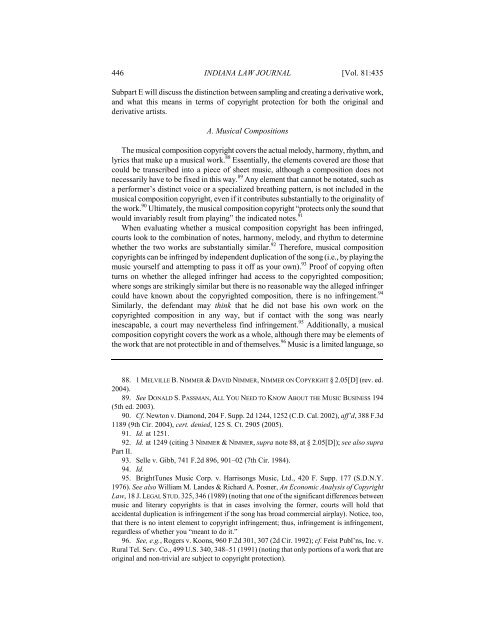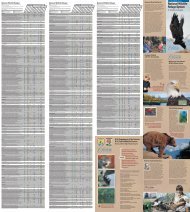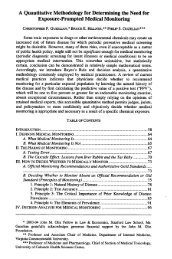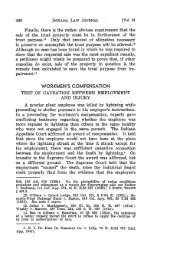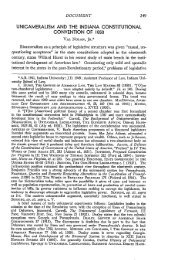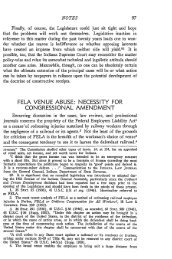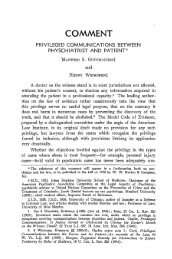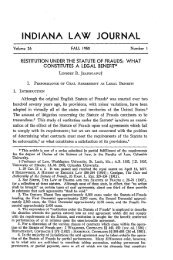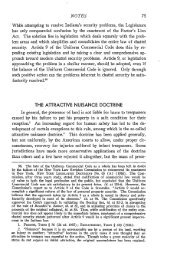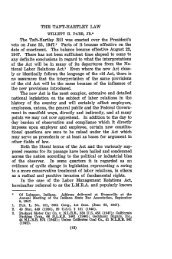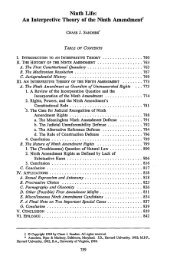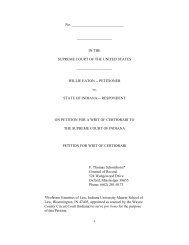Bridgeport Music v. Dimension Films - Indiana University School of ...
Bridgeport Music v. Dimension Films - Indiana University School of ...
Bridgeport Music v. Dimension Films - Indiana University School of ...
You also want an ePaper? Increase the reach of your titles
YUMPU automatically turns print PDFs into web optimized ePapers that Google loves.
446 INDIANA LAW JOURNAL [Vol. 81:435<br />
Subpart E will discuss the distinction between sampling and creating a derivative work,<br />
and what this means in terms <strong>of</strong> copyright protection for both the original and<br />
derivative artists.<br />
A. <strong>Music</strong>al Compositions<br />
The musical composition copyright covers the actual melody, harmony, rhythm, and<br />
lyrics that make up a musical work. 88 Essentially, the elements covered are those that<br />
could be transcribed into a piece <strong>of</strong> sheet music, although a composition does not<br />
necessarily have to be fixed in this way. 89 Any element that cannot be notated, such as<br />
a performer’s distinct voice or a specialized breathing pattern, is not included in the<br />
musical composition copyright, even if it contributes substantially to the originality <strong>of</strong><br />
the work. 90 Ultimately, the musical composition copyright “protects only the sound that<br />
would invariably result from playing” the indicated notes. 91<br />
When evaluating whether a musical composition copyright has been infringed,<br />
courts look to the combination <strong>of</strong> notes, harmony, melody, and rhythm to determine<br />
whether the two works are substantially similar. 92 Therefore, musical composition<br />
copyrights can be infringed by independent duplication <strong>of</strong> the song (i.e., by playing the<br />
music yourself and attempting to pass it <strong>of</strong>f as your own). 93 Pro<strong>of</strong> <strong>of</strong> copying <strong>of</strong>ten<br />
turns on whether the alleged infringer had access to the copyrighted composition;<br />
where songs are strikingly similar but there is no reasonable way the alleged infringer<br />
could have known about the copyrighted composition, there is no infringement. 94<br />
Similarly, the defendant may think that he did not base his own work on the<br />
copyrighted composition in any way, but if contact with the song was nearly<br />
inescapable, a court may nevertheless find infringement. 95 Additionally, a musical<br />
composition copyright covers the work as a whole, although there may be elements <strong>of</strong><br />
the work that are not protectible in and <strong>of</strong> themselves. 96 <strong>Music</strong> is a limited language, so<br />
88. 1 MELVILLE B. NIMMER & DAVID NIMMER, NIMMER ON COPYRIGHT § 2.05[D] (rev. ed.<br />
2004).<br />
89. See DONALD S. PASSMAN, ALL YOU NEED TO KNOW ABOUT THE MUSIC BUSINESS 194<br />
(5th ed. 2003).<br />
90. Cf. Newton v. Diamond, 204 F. Supp. 2d 1244, 1252 (C.D. Cal. 2002), aff’d, 388 F.3d<br />
1189 (9th Cir. 2004), cert. denied, 125 S. Ct. 2905 (2005).<br />
91. Id. at 1251.<br />
92. Id. at 1249 (citing 3 NIMMER & NIMMER, supra note 88, at § 2.05[D]); see also supra<br />
Part II.<br />
93. Selle v. Gibb, 741 F.2d 896, 901–02 (7th Cir. 1984).<br />
94. Id.<br />
95. BrightTunes <strong>Music</strong> Corp. v. Harrisongs <strong>Music</strong>, Ltd., 420 F. Supp. 177 (S.D.N.Y.<br />
1976). See also William M. Landes & Richard A. Posner, An Economic Analysis <strong>of</strong> Copyright<br />
Law, 18 J. LEGAL STUD. 325, 346 (1989) (noting that one <strong>of</strong> the significant differences between<br />
music and literary copyrights is that in cases involving the former, courts will hold that<br />
accidental duplication is infringement if the song has broad commercial airplay). Notice, too,<br />
that there is no intent element to copyright infringement; thus, infringement is infringement,<br />
regardless <strong>of</strong> whether you “meant to do it.”<br />
96. See, e.g., Rogers v. Koons, 960 F.2d 301, 307 (2d Cir. 1992); cf. Feist Publ’ns, Inc. v.<br />
Rural Tel. Serv. Co., 499 U.S. 340, 348–51 (1991) (noting that only portions <strong>of</strong> a work that are<br />
original and non-trivial are subject to copyright protection).


